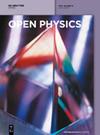Thermal transport energy performance on tangent hyperbolic hybrid nanofluids and their implementation in concentrated solar aircraft wings
IF 1.8
4区 物理与天体物理
Q2 PHYSICS, MULTIDISCIPLINARY
引用次数: 0
Abstract
The primary heat source from the sunlight is solar energy (SE), which is used in photovoltaic (PV) panels, solar power plates, PV, streetlights, and solar-based hybrid nanocomposites. Currently, research is focused on analyzing and improving the efficiency of SE, particularly for powering aircraft, by combining solar power with nanotechnology advancements. As such, this study focuses on examining concentrated solar power and proposes a method to improve the performance of solar airplanes by employing nanotechnology. Furthermore, the work is based on the investigation of the flow rate, thermal distribution, and entropy generation of the magnetized tangent hyperbolic hybrid nanofluid (HNF) along the interior parabolic solar trough collector of an aircraft wing. This work utilizes similarity variables to simplify the partial derivative model into ordinary differential equations. These equations are then solved using the Galerkin weighted residual approach with the help of MATHEMATICA 11.3 software. From the obtained outcomes, it is reflected that the HNFs have high thermal conductivity than the NF. Intensification of Weissenberg number improves the performance of airplane wings subjected to heat transmission. Therefore, this research contributes to improved thermal management in advanced nanotechnology and solar aircraft.切线双曲混合纳米流体的热传输能量性能及其在聚光太阳能飞机机翼中的应用
太阳能(SE)是来自太阳光的主要热源,可用于光伏(PV)板、太阳能发电板、光伏、路灯和基于太阳能的混合纳米复合材料。目前,研究的重点是通过将太阳能与纳米技术的进步相结合,分析和提高太阳能电池的效率,特别是为飞机供电的效率。因此,本研究重点研究聚光太阳能,并提出一种通过采用纳米技术提高太阳能飞机性能的方法。此外,该研究还基于对飞机机翼内部抛物面太阳能槽集热器沿磁化切线双曲混合纳米流体(HNF)的流速、热分布和熵产生的研究。这项研究利用相似变量将偏导数模型简化为常微分方程。然后,在 MATHEMATICA 11.3 软件的帮助下,使用 Galerkin 加权残差法对这些方程进行求解。从得到的结果来看,HNF 比 NF 具有更高的热导率。韦森伯格数的增加可改善飞机机翼的传热性能。因此,这项研究有助于改进先进纳米技术和太阳能飞机的热管理。
本文章由计算机程序翻译,如有差异,请以英文原文为准。
求助全文
约1分钟内获得全文
求助全文
来源期刊

Open Physics
PHYSICS, MULTIDISCIPLINARY-
CiteScore
3.20
自引率
5.30%
发文量
82
审稿时长
18 weeks
期刊介绍:
Open Physics is a peer-reviewed, open access, electronic journal devoted to the publication of fundamental research results in all fields of physics. The journal provides the readers with free, instant, and permanent access to all content worldwide; and the authors with extensive promotion of published articles, long-time preservation, language-correction services, no space constraints and immediate publication. Our standard policy requires each paper to be reviewed by at least two Referees and the peer-review process is single-blind.
 求助内容:
求助内容: 应助结果提醒方式:
应助结果提醒方式:


